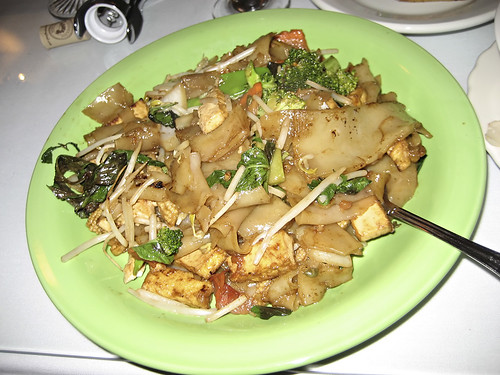Not Madison Square Garden (nor the joke that is the Isiah Thomas led New York Knicks), but rather that oft maligned substance, glutamate.

Cooks around the world have remained dedicated to MSG, even though they may not know it by that name. As hydrolyzed soy protein or autolyzed yeast, it adds flavor to the canned chicken broth and to the packs of onion soup mix used by American home cooks, and to the cheese Goldfish crackers and the low-fat yogurts in many lunchboxes.
It is the taste of Marmite in the United Kingdom, of Golden Mountain sauce in Thailand, of Goya Sazón on the Latin islands of the Caribbean, of Salsa Lizano in Costa Rica and of Kewpie mayonnaise in Japan.
“It’s all the same thing: glutamate,” said Dr. Nuripa Chaudhari of the University of Miami, who was part of the first research team to identify human glutamate receptors.
In September Dr. Chaudhari will take part in the University of Tokyo’s centenary celebrations honoring Prof. Kikunae Ikeda’s 1908 discovery of glutamate flavor. The Japanese company Ajinomoto turned that discovery into crystalline powder form, MSG, and patented it in 1909.
“Just like salt and sugar, it exists in nature, it tastes good at normal levels, but large amounts at high concentrations taste strange and aren’t that good for you,” Dr. Chaudhari said.
If you live in the United States and like spicy tuna rolls, Puerto Rican roast pork or Thai noodles, there is a good chance you are eating, and enjoying, MSG.
[From Yes, MSG, the Secret Behind the Savor - New York Times]
I don't eat spicy tuna rolls usually (two day-old fish is frequently used, the spoiled-fish taste masked underneath the spice), but Drunken Thai noodles are a staple of my diet.
Maggi sauce (there are various other Maggi products, not all of which contain MSG) is extremely popular in regions as far-flung as India, Mexico, the Philippines and the Ivory Coast. One of Thailand’s favorite late-night street foods, pad kee mao, or drunkard’s noodles, relies on its sweet-salty-meaty taste; the Malaysian version is called Maggi goreng.and I've been meaning to blog about the elusive fifth taste, umami, for quite some time. We are quite partial to umami, and most meals we prepare contain some natural source of it.
In upscale restaurants, whether by tradition or by inclination, chefs are unlikely to use monosodium glutamate. “We don’t need to use Ajinomoto because we can get the ingredients that have natural umami: shiitake mushrooms, egg yolks, shellfish, masago,” said Sotohiro Kosugi, the chef of Soto in New York.and if you thought you have been avoiding MSG all these years, guess again:
Although umami is only a bit player in Japanese cuisine, reams of breathless prose have been produced here on this elusive fifth taste, which is supposedly linked to the profoundly pure, deep-sea flavors of kelp and dried tuna.
Umami “is delicious,” Katsuhiro Utada told The New York Times in 1983, and a food-lovers’ swoon began. Mr. Utada, not coincidentally, was the president of the Ajinomoto Company — then, and now, the world’s largest producer of monosodium glutamate.
Whether umami is the fifth taste or the 50th — there is little agreement among neuroscientists — it has been positively identified as the flavor of glutamic acid, an amino acid naturally present in many savory foods, from seaweed to soppressata. Food writers lost no time adding umami to their mental glossaries. But this same crowd rarely mentions MSG, a cheap, synthetic route to the flavor of glutamate.
Since the 1970s, MSG has sidled back onto American supermarket shelves, under assumed names: hydrolyzed proteins, yeast extracts, protein concentrates and other additives that are not labeled as MSG but, according to nutritionists and the United States Department of Agriculture, are essentially the same thing: synthetically produced glutamates.
The whey protein concentrate and liquid aminos that many Americans buy at health food stores are also, essentially, pure glutamate, Dr. Chaudhari said.
According to U.S.D.A. guidelines, “labeling is required when MSG is added as a direct ingredient.” But other glutamates — the hydrolyzed proteins, the autolyzed yeasts and the protein concentrates, which the U.S.D.A. acknowledges are related to MSG — must be identified under their own names.
Alternatively, they may also be included under certain terms, like vegetable broth or chicken broth. Thus, these ingredients are now routinely found in products like canned tuna (vegetable broth is listed as an ingredient; it contains hydrolyzed soy protein), canned soup, low-fat yogurts and ice creams, chips and virtually everything ranch-flavored or cheese-flavored.
Thus, the richest source of umami remains your local convenience store. Grab a tube of Pringles or a bologna sandwich, and glutamic acid is most likely lurking there somewhere.
Nacho-cheese-flavor Doritos, which contain five separate forms of glutamate, may be even richer in umami than the finest kombu dashi (kelp stock) in Japan.
